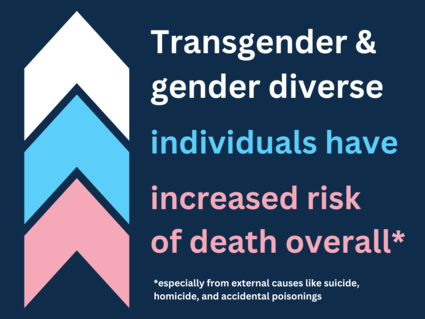Transgender and Gender Diverse Individuals Cancer Risk Study
Background & Purpose
Cancer risk has not been investigated sufficiently in transgender and gender-diverse individuals. It is estimated that 0.6% of US adults are transgender, about 1.4 million individuals in 2014. There are four main risk factors that we think may affect the risk of cancer among transgender people:
- barriers to healthcare
- viral infections
- behavioral factors
- gender-affirming hormone use
We have initiated a study using the UK Clinical Practice Research Datalink or CPRD—a primary care database that covers 15% of the UK population—to evaluate cancer risk factors, cancer screening uptake, cancer incidence, and mortality. We identified transgender and gender-diverse patients using diagnosis codes and matched them to cisgender people on clinical practice, age, and index date.
See all studies in descriptive epidemiology, infectious agents, and exogenous hormones. Read about the importance of including transgender individuals in studies of cancer risk.
Study Team
Investigators
Sarah S. Jackson, Ph.D., M.P.H., Earl Stadtman Investigator
Branch
Study Design
UK Clinical Practice Research Datalink was used to build a cohort of more than 7,000 transgender and gender-diverse individuals matched to 280,000 cisgender individuals for comparison. The cohort covers the period 1988–2020.
We extracted important data from the electronic medical records on cancer risk factors (e.g., smoking, viral infections, gender-affirming hormone therapy), cancer screening, cancer incidence, and mortality. We linked CPRD records to the Hospital and Episodes Statistics and Office of National Statistics to obtain data on hospitalizations and deaths.
Select Publications
Brown J et al. Prevalence of cancer risk factors among transgender and gender diverse individuals: a cross-sectional analysis using UK primary care data. Br J Gen Pract. 2023.
Jackson SS et al. Analysis of mortality among transgender and gender diverse adults in England. JAMA Netw Open 2023.
Jackson SS, et al. Understanding the role of sex hormones in cancer for the transgender community. Trends Cancer 2022.
Jackson SS et al. Cancer stage, treatment, and survival among transgender patients in the United States. J Natl Cancer Inst 2021.
Research Findings in the News
Transgender Patients and Cancer Disparities


